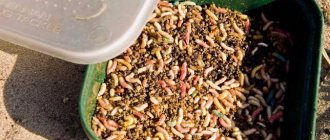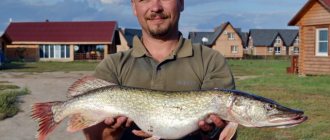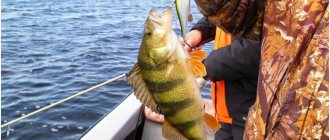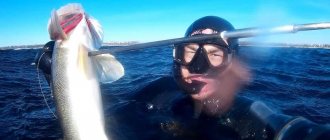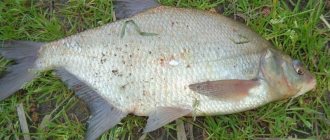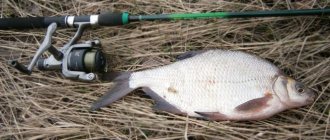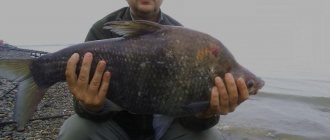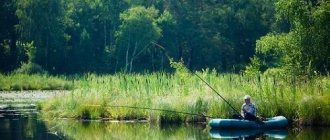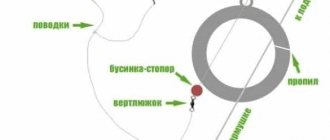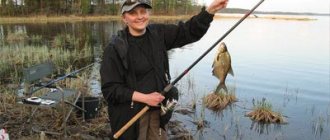Bream fishing - how to ensure successful fishing
Fishing, for me, is the best topic of conversation at any time of the day.
A special place in it is occupied by the preparation process, and, naturally, the fishing process itself. It just so happens that I have been accustomed to it since childhood and still love to spend time with a fishing rod on a river or pond. So, I am pleased to share with you my impressions of this wonderful pastime. The topic of our conversation is bream fishing. For starters, the most wonderful aphorism from the book of the famous writer L.P. Sabaneev: - “Time spent fishing does not count towards life.” This time is not just pleasure and a healthy lifestyle, but a piggy bank for our longevity.
A few words about the fish itself
Bream is perhaps the most popular fish eaten by humans. Lives almost in
in all reservoirs, reaches quite large sizes - 3 and sometimes more kilograms. The record for caught bream weighing 11.55 kg was recorded in Finland, Lake. Vesijärvi, in July 1912.
Favorite places where bream fishing is guaranteed are not fast, but rather slow flowing water and a depth of approximately 2 to 3 meters. In everyday life, among amateur fishermen, this type of fish within one kilogram is called a bream. But this does not change the essence, since in any type of preparation it has excellent taste. Moreover, it contains many vitamins and microelements.
Bream fishing on my beloved Volga
July is the best time to catch bream and bream on the Volga River. The water has warmed up to the required temperatures, which allows you to fish with a float rod. At this time of year, in search of food, it comes close to the shore, where it can be successfully caught. It must be said that catching almost all “white” fish requires skill and skill from the fisherman. I call myself a Volzhanian because I was born in the Saratov region and lived in the fishing town of Astrakhan for more than 30 years. Therefore, in a natural way, I was able to learn from wiser fishermen certain experience and skill in amateur fishing for various types of fish.
As mentioned above, in the summer it is best to catch bream in the first half of July. And there are quite objective reasons for this: • bream, as a schooling fish, lives better in cool water and does not really like very warm water; • oxygen and its saturation in water plays an important role; • strong heating of water, especially in weakly flowing places, leads to flowering, which bream also does not like;
Bream fishing - rod and tackle
It is best to choose a fishing rod with a length of 6-7 meters. This is the best option. If the rod is short, then it will be simply impossible to reach the places where large bream lives. The main line, its optimal thickness should be at least 0.20 mm, the leash - 0.18 mm. The float is selected according to two parameters: - this is the load capacity and the shape, which should respectively be 4-5 grams and relative to the shape - it is best suited in the form of a needle.
It has very little resistance to immersion in water during a bite. The more
resistance, the greater the likelihood that the bream may simply move away from the treat on the hook.
Recommendations regarding the choice of hook. From the experience of most amateur fishermen, No. 3, preferably black, is most suitable. This will provide him with complete invisibility in the water.
Fishing for bream - groundbait and bait
Modern mixtures, which are sold as food in fishing stores, do not replace bait, which you can prepare yourself. It is prepared as follows: 1 kg of millet cereal is poured into a suitable container, filled with water so that its level is three centimeters higher than the cereal and cooked.
Porridge is usually prepared in the evening and should be cooked over medium heat until the water has completely boiled away. In the morning, take it out of the pan entirely, in the form of a pie. When fishing, you will cut off a piece of this pie with a knife and throw it into the water. We do the same with preparing one kilogram of pearl barley.
The bait to choose from is maggot, bloodworm, pearl barley or a regular earthworm. It is recommended to take this entire set of bait, because it is difficult to guess which of them the bream will bite on that day.
How to catch
Before starting bream fishing, a fishing spot on the shore is set up for personal convenience so that everything is at hand. Then we feed the place. To do this, just throw 5-6 lumps of pearl barley and millet into the work area. First, two bloodworms are placed on the hook so that it cannot fly off during casting, and then two maggots - as they say, as much as profit, so will you live.
All that remains is to wish - catch a small fish, a big one. I recommend that you read another interesting content about fishing on the Volga . Friends, good luck to you and good mood for many years to come!
I am glad to see you on the pages of the site and I will be grateful if you leave your review or comment on the topic!
Source: weblavr.ru
Feeding fish on the Volga
As for feeding the place where bream is caught from a boat, you can prepare a mixture that the bream will definitely like. You should add something from animal food to the mixture, for example, bloodworms or maggots, and then add some plant components. Form several balls and feed the bream in the place where you catch it.
Also an excellent recipe for catching bream on the Volga is a mixture of soil from the Volga banks and chopped worms. Also form balls from the resulting mixture and feed the fish even in those places where there are nets. It is important to remember that the bait should not immediately settle to the bottom. If the current is strong, throw large bait balls first, and then smaller ones.
Bait can also be varied. Volga fishermen say that even pearl barley, which bream likes, will do. You can also use worms. Volga fish love ordinary worms, but they prefer dung worms, since they are able to lure them with the special smell that they emit. In addition, they will visibly squirm on the hook and will immediately attract bream.
There are also various recipes. You can mix maggots and bloodworms, because bream can be picky and don’t like other baits. But a bloodworm will always do. Combine it with corn, which will certainly give you a bite not only of bream, but also of roach or ide.
Now that you are well versed in all the intricacies of Volga bream fishing, you can safely go to those quiet and picturesque spaces. Fishing in these places in summer and autumn-spring will bring you not only unforgettable impressions of the beauty of nature and a feeling of tranquility, but also large bream, which you can safely call Volga trophies.
Features of bream fishing in Astrakhan
As practice shows, the depth at the place where bream is caught should have average values in relation to the reservoir in which the fishing is carried out. For example, if on a particular river there are holes with a depth of 10-12 meters or more, then a depth of 5-7 m will be sufficient for fishing. It is much more important in this situation to have an idea of the structure of the bottom at the fishing site. Bream prefers to feed on a hard or slightly muddy bottom, where the thickness of the mud layer is no more than 10 cm. You can check the thickness of the mud layer using a lead weight weighing about half a kilogram. On a thin silt layer, such a load only easily falls through the silt, resting on the hard bottom. An additional landmark for such places are small thickets of lilies and water lilies near the shore. In these lilies, RїSЏS‚РЅРестая хищнРеца — щука likes to stay so much. Bream by nature is a very cautious fish. Caution is always with him, except in places where the road passes too close to a body of water. But at the same time, keep in mind that even a slight slam of a car door near the fishing spot at night can scare away cautious fish for one to two hours. The bream bite in the Astrakhan region begins as soon as the water recedes at the end of April. Having become fairly hungry during hibernation, bream on the lower Volga bite well before spawning. Then, during the spawning period, the fish’s bite weakens. And after spawning, the bite of Astrakhan bream becomes especially greedy, so May-June in the Volga delta are the best months for catching this fish.
the period from July to mid-August, bream on Ахтубе is caught worse and worse. The bite picks up only when, due to cold weather, the aquatic plants become sufficiently coarse, and at the same time the amount of natural food - aquatic insects and larvae - decreases. In such favorable conditions, bream fishing can continue until mid-October, after which the fish gather in schools and move into deep holes. In mid-summer on the lower Volga, bream are found in deep places, and come to the shore only on cloudy days or at night. You can notice a school of bream in the evening by the characteristic air bubbles that rise from the bottom in local areas. Most often, massive bubbles give away the location of schooling bream when they dig in the mud. It’s worth trying to catch such places first. The time interval from feeding to the first bite of bream can reach 15 minutes, or it can take several hours. I remember a case when I fed a lot in the evening, but the bites only started in the morning. To avoid such an unforgivable waste of time, I suggest first feeding for a day or two, and then going out to catch bream. Bait for bream is done as follows: take a kilogram of peas and a couple of kilograms of selected wheat, put 8 liters of water on the fire until it boils (a 12 liter bucket is suitable as a vessel, which must be thoroughly washed before cooking). As soon as the water in the bucket boils, throw in a teaspoon of salt, pour wheat into the water, reduce the gas and close the lid for one hour. After this, we add peas to the steamed wheat, and then again let the bream bait simmer for about 20 minutes. At the next stage, we add a glass of ground and toasted flaxseeds to our bait, remove the bucket from the heat, cover with a lid and wrap in a blanket for 4 hours. During this preparation, the peas and wheat in the complementary foods will acquire such density that they are quite suitable for shooting from a gun :)
Catching large bream on the lower Volga using a donkey with an elastic band
To catch bream, I use a rubber band, with the help of which the bait is delivered to the baited place, which is very difficult to do with a simple donkey, especially in the dark. At the junction of the elastic and fishing line with the first hook, I place a foam float to indicate the place of bait. The weight from the bottom for catching bream is brought by boat 70 meters from the shore, I tie 20 meters of elastic to it using a nylon cord, and then a fishing line with leashes (no more than 5 pieces). To prevent the leaders from twisting, you can use triple swivels or use two carabiners on each side of the line. In addition, it is possible to use a dark button with two holes for these purposes. On the main line, between two knots, we put a button through one of its holes, and thread a leash with a hook into the other hole of the button. Before you start feeding bream, it is necessary to assess the lateral currents near a particular reservoir in the Volga delta.
When, with a crosswind, there is a possibility of a noticeable bottom current, which is directed in the opposite direction with respect to the direction of the wind. In such conditions, the foam floats at the hooks will be pulled in the direction opposite to the wave. This happens because the rubber band in such conditions begins to play the role of an underwater sail, which obeys the force of the bottom current. After that, I remove the foam plugs from the hooks and bait the worms there. In my many years of experience, it is worms that are best suited as bait for large bream on the lower Volga. It’s better not to spare the worms, but to plant 3 pieces. We use a large hook for bottom fishing - No. 8-10 according to domestic numbering. It must be remembered that bream has a very keen sense of smell, so the tackle should not emit any foreign odors. It is useful to wipe all equipment elements with linseed or sunflower oil to eliminate foreign odors. Otherwise, you can forget about catching a really large bream. If, before fishing, your donka lay in the trunk of a car next to a can of gasoline, then you can’t expect outstanding results either. When catching large bream, patience and perseverance are required; empty fishing trips often occur. The main reasons for the flights are the discrepancy between the current weather and the desire to feed on our golden friend. The best bite for bream occurs during the waxing moon and during the new moon, but the phases of the moon affect the bite to a lesser extent. The drop in atmospheric pressure, at which the bream stops feeding, has a much stronger effect. In the Astrakhan region, stable or increasing pressure with values from 745 mm Hg is best suited for catching bream. The autumn bite for bream on the lower Volga turns out to be much more stable than the summer one, since the fish gather in schools and begin to fatten before wintering. Large bream stop feeding at the end of October, after which they emerge from wintering pits only at the end of December or already at the beginning of January. Large bream bites very characteristically; its bite is difficult to confuse with other fish. During the bite, the guard shudders slightly and moves back a little, after which there is a short pause (at this time the bream swallows the bait), and then the guard begins to move forward. At this very moment is the best time to perform the hook. At the very beginning, a kind of dull hook is felt, after which the situation changes and something alive begins to be felt at the other end of the fishing line. 5-6 seconds after hooking, you can begin to reel the line towards you. When catching large bream in Astrakhan, it is not recommended to use leashes thinner than 0.2 mm; in extreme cases, you can go down to 0.17 mm (a lot of thrills in this case are guaranteed to you). As practice shows, thicker leashes do not have the best effect on the number of bites. Fishing for bream is performed with soft hand movements using grips of 20-40 cm. When fishing with bottom tackle, when fishing near the shore, the bream does not lie on its side, but takes a vertical position until the last moment. This creates certain difficulties when sucking, so some skill is required, the main thing here is not to rush. You can adapt to picking up bream with your hands, because in the dark the bream behaves completely calmly. It is helpful to dim your headlamp slightly to avoid irritating the bream in the dark. As for the time when you can catch the largest bream, it is mainly dark. In summer the best time is 1.5 hours before dawn, and in autumn 2-3 hours before sunrise. During this period, the largest number of bites from large fish occur. In shallow reservoirs, Astrakhan bream can bite from 6 a.m. until lunchtime. In my practice, there have been cases of bream biting even after lunch, but this should be regarded as an exception. In general, I would like to note that night fishing for bream on a donk in any large area of the lower Volga is a kind of aerobatics. Amazing night nature, splashes of large fish in the dark, the squeak of bats overhead, steam from the water, all this gives fishing a special atmosphere and is remembered on long winter evenings.
Source: www.w-fish.ru
Bream feeder
- To properly make feeder gear for bream, you need to understand the conditions under which it will be used. For large rivers, such as the Volga, Oka, Don, you will need a Heavy or Extra Heavy rod of normal length class with the appropriate equipment - to make long, accurate casts in wind and current conditions. Medium calibers are more suitable for medium-sized rivers and lakes.
- Picker for bream is a rare thing, applicable only on small rivers and reservoirs, where this fish can be fed close to the shore. There is no universal option, but for an amateur who does not have an arsenal of rods for each specific condition, he needs to choose a heavier option. You can fish with a heavy one at close range, but not with a picker at a long distance with heavy feeders.
Rods
The entire structure of the feeder tackle for bream is determined by the caliber of the tackle. The required test and the power of the reel depend on the weight of the feeders and the fishing range.
- The gear for catching bream with a feeder from the shore on large rivers is a rod with a weight of 90 grams or more, length from 3.9 meters. More details - long-range feeder for current.
- On medium-sized rivers, where long-distance casting may also be necessary, a medium rig (Medium rod) up to 90 grams, 3.6-3.9 meters long, is suitable. But if this small river has a strong current and you need to use feeder feeders of 100 g or more, a heavy river feeder is better suited than a station wagon.
- In lakes and reservoirs where fishing takes place at close range, you can use a Picker or a light feeder up to 40 g (Light). But still, the casting distance is usually longer. You need to cast to the bottom edge, so, again, the angler needs a long rod that can deliver the equipment over such a distance. There are usually no currents in reservoirs, but there is a draft due to water discharges in the locks, so even on such reservoirs heavy feeder feeders are sometimes needed. Therefore, in 90% of cases, the bream feeder is a long rod, from 3.6 meters, medium or heavy river rod.
- Everyone chooses equipment based on local conditions. If an angler spends most of his fishing on the Volga, then he definitely needs a powerful river feeder. If the river allows feeders up to 80 grams and casts up to 60 meters (more or further is not needed) - a medium feeder caliber will suffice.
On large reservoirs with a shoreline completely overgrown with reeds, the use of boats is justified. Long distances are rarely used to cast a feeder from a boat, and if there is no strong current, short pickers, up to 2.4 meters, are suitable. On the current, you need to use powerful short rods with high test weight - 120 grams, such are present in the line of some manufacturers.
In the bream feeder gear, you need to take into account such a characteristic as structure. This most likely applies to more or less expensive models. Cheap fiberglass clubs usually have a fast action (Fast), but under mega load (which bream cannot give) they bend along the entire length. More expensive carbon poles can be found in both fast action and slow action.
There is no best among them - it depends on the angler. Some people like hard rapiers, in which only the upper part bends, while others prefer noodle-like soft rods. The most normal option is the Progressive system, when the upper third of the blank works under a small load, and the entire length works under a serious load. An article about choosing a feeder rod.
Feeder reels
The reel is selected depending on the caliber of the rod. You can use suitable universal coils or special feeder coils. More details - the correct coils for the feeder. On a heavy river boat we install a spinning reel with a spool size of 5000 or higher, in extreme cases - 4000 if the reel is high-torque and calmly pulls large loads from afar. The standard size for all light and medium class feeders is 4000, and for pickers - 2000 or 3000 thousand. If in doubt, take the one that is larger.
High-speed spinning reels are not suitable for the feeder - you need a lower-speed, but traction one. The gear ratio for the feeder is from 4.5:1 to 5.5:1, where the number in front of the unit indicates how many revolutions the reel makes per turn of the handle. High-speed reels with a gear ratio of 6.2 and higher are convenient for high-speed fishing with a spinning rod, but in the feeder they will be difficult to reel in heavy feeders.
The presence of a baitrunner or a rear flag in the gear for catching bream on a feeder is not for everybody; these devices are needed more for carp fishing. The main thing is that the feeder clutch is long, no matter whether it is rear or front.
The technique of tempo feeder fishing, frequent casts and, possibly, large fish on thin leashes, force you to clearly adjust the clutch and constantly work with it. When choosing a feeder reel, you should pay attention to the depth of the spool and the clip.
Clipping in feeder fishing is an important part of the technique. The cord should not be chafed by the irregularities of the incorrect clip. It is convenient when the reel kit comes with an additional small feeder (match) spool - this is convenient for winding thin braid, without backing.
Cord and fishing line
In gear for long casting, a braided cord is used in the feeder. For short feeder distances, you can take braid of mediocre quality, and compensate for the weakness of small diameters with a thickness of about 14-0.16 mm. However, the casting range and the stability of the equipment in the current are important for the river fisherman. A thick fence reduces the range and is inflated by the flow of water into a loop.
A thin high-quality cord (10-12lb) allows you to make the longest casts; when fishing in strong currents with thin braid, you can use lighter feeders - they will not be carried away by the draft. However, thin cords with a diameter of 0.1-0.12 mm can only be used of high quality, with good tensile strength. For example, WFT Strong braid with a diameter of 0.08 mm can withstand a tensile strength of 10 kg (!), however, such a cord costs under 2000 rubles for 150 meters.
To choose a braided line for a bream feeder for long-distance casting in strong currents, we proceed from the fishing conditions and willingness to pay money. If you are willing to pay, we take something like WFT Strong or PE Sport Max X8, 0.08-0.1 mm. If not, something simpler from the middle price category, 0.12-0.13 mm. Of the cheap cords - about 14-0.16, since a thin, bad cord simply will not withstand long-distance work with heavy rigs in conditions of sharp edges with shells and grass.
In order not to break the cord during power casts, we use a shock leader. As a shock, you can use a thicker cord 0.19-0.22 mm or monofilament up to 0.3 mm. The shock leader made of monk cushions the rig a little, but the connection point with the main cord is large and hits the rings harder. On a braided knot the knot is much less voluminous. We tie the main feeder cord and the shock leader with a carrot knot - we get a cone that easily passes through the rings. The length of the shock leader should cover the working overhang for casting, the length of the rod and several turns on the reel for comfortable casting.
fishing line
In the spring, when a lot of debris and mud floats along the river, it all clings to the cord and, when reeled in, gets clogged in the rings of the feeder rod. Sometimes there are so many of these particles that it is almost impossible to catch - after each reeling, the quivertip tulip becomes clogged. In such conditions, it is more rational to use monofilament. The feeder usually uses monofilament fishing line with a diameter of about 25-0.3 mm. We choose a non-stretchable fishing line, otherwise the bites will not be visible. All this debris clings less to the monofilament. What fishing line should I put on the bream feeder?
The monofilament is thicker, inflates more strongly with the current, and hides bites. Therefore, long feeder distances over 70 meters are not available. But at distances of up to 60 meters you can fish quite comfortably with a fishing line. A bream fishing line for a feeder is a completely working solution for short and medium distances. The main thing, we repeat, is the rigidity and inextensibility of the equipment. Usually on such fishing lines it is directly indicated - Feeder.
Monofilament is also used on pickers - long casting is not needed, and the shock absorption when biting large fish is better. For picker, the fishing line is taken thinner - 0.2-0.25 mm, since heavy feeders are not used here. Each feeder should have a regular fishing line wound on the spare spool of the reel - you never know in what conditions you will have to fish. The fishing line might come in handy.
Feeders
Installing a feeder for bream is done in the same way as when catching other fish. It all depends on the immediate working equipment. The fastening of the feeder feeder is standard - usually through a carabiner with a swivel (with a bead for inline). You need to tie a feeder tackle for bream taking into account the conditions of the reservoir described above and the weight of the equipment. You can equip a feeder rod for bream fishing with one of many feeders of various configurations, suitable in weight.
More often, open-type feeders and cages are used in the feeder. They usually have a rectangular or cylindrical feed cup shape. The cage itself can be plastic or metal. The choice of feeders for long-distance fishing in current conditions must be approached thoroughly. Firstly, the equipment should fly well, and secondly, it should stand stably on the bottom and not be pulled down by the current.
Rig Pro 60 grams
In feeder fishing for bream, such a moment as washing out the food is important. In a strong flow, you can go in two ways to regulate the speed of washout. To increase this time, and also to protect the bait from being washed out while diving to the point, we make the mixture more viscous or use closed feeders. The feeder must have a set of different feeder feeders, and in a particular fishing area, the option that will work correctly here is selected. You don’t need any bells and whistles; the simpler and more reliable, the better. The following parameters are really important:
- Weight;
- Shape (relative to stability in the current) - square cage, round (curlers), triangular. Some anglers believe that square feeders lie better than round ones. But this is not so - the right curlers with a flat weight across the entire width, with recesses along the rounded outline of the glass (RigPro, Flagman) stick perfectly to the bottom, but fly better, since they do not have wide flat edges.
- Feed capacity;
- Holes, mesh size in the glass (relative to the washability of the bait).
Vegas with wings
For particularly long casts, use bullet feeders or cups with special placement of the load. Glasses are better in this regard - they fly just as well as bullets, but they float up better, since when pulled out they have a hole that spans the entire width, not covered by a load (like in a bullet). The bullet is very good for casting, but it floats up hard, which makes it awkward in places with a steep edge.
For easy ascent, you can use plastic feeders with guide wings. Such rigs float up perfectly from under any edge. However, in a strong current, because of these wings, they are more strongly carried away by the flow while falling to the bottom - you may not get to the fishing point at all.
Bullets
At the strongest flows, you can generally use closed feeders in the equipment or wrap the nets with special covers or electrical tape. By the way, electrical tape has its own glue smell, which can scare away fish. Therefore, this issue is controversial; it is better to use a feeder with a glass without holes. When rigging a bream feeder, the good old bottom rigs – springs, watermelons, nipples – are often used. But that’s another story, the articles are in the section on bottom fishing.
The feeder’s task is, during preparation after measuring the bottom, to select a feeder for the equipment according to weight and configuration, which is convenient to throw at one point and take out from it. In this case, the equipment should not be carried away by the current while at the point. Secondly, think about the issue of washing out the feed and, depending on the consistency of the bait, the depth and strength of the current, choose a more open or closed version of the feeder glass. An article about the types of feeder feeders.
With small holes for flow
Setting up the boat at the fishing spot
From the list of all types of watercraft used for fishing, the rubber inflatable boat has proven itself to be the best for ring fishing. Iron vessels (boats, not motorboats) are impractical because they make loud “metallic” sounds with the slightest movement. Wooden boats have the same , although not to the least extent.
Even on a rubber inflatable boat it is necessary to lead such a life very quietly, because with this method you have to fish directly from under the boat. Installation recommendation. Anchoring with one anchor will not bring success. The boat, together with the fisherman and not the feeder, will be dragged around the water area in our client’s left side, during the day the wind will probably change direction a couple of times.
The presented sketch is somewhat naive in terms of anchoring, as mentioned above, but quite accurately illustrates the fishing method. To clearly establish the correct stability at the fishing site, you should set the boat “on a stretch”, using 2 anchors. For this purpose, you will need, in addition to the anchors, 50 meters of strong cord. The operation must be performed in the following order:
- Tie an anchor to one end of the cord and do not lower it to the bottom.
- Pull the cord through the bow and stern loops on the boat.
- Tie the 2nd anchor.
- Using the oars, move the boat along the fairway to the full length of the cord.
- Lower the 2nd anchor.
- Having pulled yourself up by the cord to the place designated for fishing, secure the cord in the bow and stern part of the boat, having previously pulled it tightly without tying the cord on the loops.
Having secured yourself in the fishing spot, lower the feeder into the water. The feeder is a mesh bag with a hole no larger than 5x5 mm, not weighing 2-3 kilograms. The cord used to hang the feeder is expected to be taut.
Catching bream with a ring: watch the video below.
Description of the gear structure
- Rod. You will like any length of 1.5–2 meters. A spinning rod with a small reel is more convenient.
- Main line. The cross-section is 0.25–0.3 mm, otherwise the braided cord is 0.2.7 mm.
- A locking device on the cord of the feeder - it is natural to tie anything, as long as the ring does not go to the feeder and does not get tangled with it. Installed 20–30 cm from the feeder.
- It is necessary to attach a ring to the main fishing line through a swivel with a carabiner using another device, the name of which replaces it is “Eggs” (more about it below).
- Next, you need to attach a leash with a hook through the swivel and with other hooks (from }textbook to three). It is better to select hooks No. 4–6 according to the European classification. Leash length up to 1.5 meters. It is better to use a fishing line with a cross-section of 0.15 mm, otherwise fluorocarbon 0.4.5 mm.
Catching bream with a ring (mad bite)
One August morning we decided to go to the middle Volga
fish from a boat using a ring. We got into a frenzy.
The figure shows the production procedure for a device called “Eggs”, invented to replace the ring in traditional gear.
For installation, the balls are moved apart and not put on the feeder cord. When bitten, they spread to the sides and do not release the cord. Winning a trophy occurs as usual. Well, what next?
Fishing for Astrakhan bream on the lower Volga
The possibilities of summer fishing in the Astrakhan region can be judged by looking at the map, where the mighty Volga River, forming numerous channels and ilmens, has provided fans and fishing enthusiasts with real freedom when choosing a fishing object. Being keen on fishing, I knew that there were a lot of large bream in the lower reaches of the Volga, but at first I came across specimens of bream up to 1 kg and bream weighing 600-800 g during the spawning feast. Having arrived in the spring for the spawning of the Astrakhan roach, you very often encounter the approach of large bream into numerous channels of the Astrakhan region, as well as buffalo and glanders. With a successful combination of circumstances, you can catch up to 10 large egg-spawned specimens during the day, not counting a large number of roach and other fish.
Lure
In most cases, the basis of bait is various cereals . For example, the famous Salapin porridge is prepared from four different cereals and boiled for many hours. Then bran, cakes, flour, corn, etc. are added to it. When fishing for bream, it can be useful to add garlic.
It should be borne in mind that the duration of fishing is usually 6–8 hours and all this time the bait must be present and working. The durability of bait depends on its consistency and the strength of the current at the fishing site. The second factor is not constant, so you need to make the bait as dense as possible. Before placing it in a bag (mesh), you need to form balls with a diameter of 8–10 cm from the bait and carefully place them in the feeder. During the fishing process, the feeder must be shaken periodically, increasing the release of turbidity to preserve the food trail.
Under no circumstances should you use tap water, whether boiled, filtered, or settled, to prepare bait. It’s better to go to the market and buy fish there.
Habits
Bream is a fairly large fish, although it is far from a record holder in terms of weight. The largest fish reach a weight of six kilograms. Most often, individuals from half a kilo to a kilogram are pecked on the hook; this fish is usually called a bream. Bream weighing three kilograms is in most cases a trophy catch.
The body shape of the bream is laterally flattened and elongated in length. This helps him avoid the teeth of the pike, which simply cannot open its mouth enough to grab a wide fish. It grows very quickly, and as a result, having reached large sizes, it has practically no natural enemies in the reservoir.
The peculiarity of its nutrition is associated with its body shape. When searching for food, bream is guided by the organs of vision, hearing, lateral line and especially smell. This fish is very sensitive to odors, which is worth taking advantage of by adding aromatics to the bait. But you shouldn’t overdo it, since a bream’s good sense of smell will immediately distinguish between a dirty trick and an unusual smell, and you will lose all bites altogether. After the bream finds food at the bottom, it takes a vertical position in the water and draws it into itself with its mouth, working with its gills. After this, the bream straightens up and moves to the side.
A bite on a float rod allows you to see this feature. When biting bream, the float never dives sharply down. Even if he bites at half-water when fishing for roach, he always lifts the float and drags it to the side. A large bream, capable of completely tearing the sinker off the bottom, can even lay the float on its side. Many other fish with a wide body shape behave in the same way - carp, crucian carp, silver carp.
Tips for choosing bait for bream
Spring baits
Depending on weather conditions in the spring, bream can actively react to different baits: March: bloodworm, worm, semolina, dough. April worm, maggot, bloodworm. May peas, corn, dough, pasta, semolina, bread, boiled wheat, pearl barley. The higher the air and water temperatures, the faster the bream switches from animal baits to plant baits.
Summer baits
In the summer heat, many complain about a complete lack of bite, but this is not always true. Properly selected bait can attract the attention of bream even in the heat. June: worm, maggot, corn, peas, pasta. July: steamed barley, maggot worms in the form of sandwiches. August: bread, pasta, corn, maggot worm. Temporary decreases in temperature indicators will entail a return of bream to animal types of bait ; vegetable bait should be offered in hot weather.
Autumn lures
In the autumn, bream continue to be actively caught on the feeder; groundbait and bait, as before, should work in tandem in such gear. As the temperature drops, bream will again want “meat” baits. September: earthworm and dung worm, maggot, hominy, bread, steamed cereals. October: bloodworms, worms, less often maggots. November: maggots and bloodworms, plant-based baits will not work. It is important to understand that the bait used in crushed form must be added to the bait .
Winter lures
In winter, bait for bream is very important; it is more difficult for passive fish to attract attention. Therefore, the selection of bait should be approached very carefully. December : sandwiches made from pieces of worms, bloodworms and maggots, less often boiled peas are used. January : bloodworm, worm. February : worm, bloodworm, semolina, peas. You can experiment and try using the dough as bait; at the end of February, bream can respond well to this species.
This type of fishing completely excludes the bite of large bream in shallow water. It simply will not be able to take the required position for eating, since it will not have enough depth, and therefore in such places you can only find a small underbreeder. In addition, you should use long leashes when fishing. The bream, when it lifts the bait and feels the weight of the sinker, will simply spit it out, and you will lose your catch. The leash must correspond to the size of the fish being caught and the hook must be at a great distance from the sinker - both in bottom fishing and in float fishing. However, you shouldn’t make it too long, as this will lose the sensitivity of the tackle, and in feeder fishing the leash will lie too far from the feeder.
Bream wintering usually takes place in very deep places, from five meters or more. In such depths there is eternal twilight, odors do not spread well in cold water. The fish's metabolism is slow due to the low water temperature. However, sometimes bream comes out to feed. It can be caught with winter fishing rods and jigs. At very great depths, from 15 meters or more, in winter, bream can be caught even in mid-water. Mostly small bream are actively biting. The bites of serious bream at this time are cautious or absent altogether. Sometimes getting warm water under the ice helps correct the situation. Then the bream becomes more active and begins to feed a little more actively.
